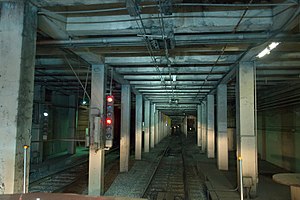| Eureka Valley | |||||||||||||||||||
|---|---|---|---|---|---|---|---|---|---|---|---|---|---|---|---|---|---|---|---|
 Remains of the inbound side of the station in 2015 Remains of the inbound side of the station in 2015 | |||||||||||||||||||
| General information | |||||||||||||||||||
| Location | Market Street between Eureka and Diamond streets San Francisco, California | ||||||||||||||||||
| Coordinates | 37°45′42.3″N 122°26′17.6″W / 37.761750°N 122.438222°W / 37.761750; -122.438222 | ||||||||||||||||||
| Owned by | San Francisco Municipal Railway | ||||||||||||||||||
| Line(s) | Twin Peaks Tunnel | ||||||||||||||||||
| Platforms | 2 side platforms | ||||||||||||||||||
| Tracks | 2 | ||||||||||||||||||
| History | |||||||||||||||||||
| Opened | February 3, 1918 | ||||||||||||||||||
| Closed | 1972 | ||||||||||||||||||
| Final services at closure | |||||||||||||||||||
| |||||||||||||||||||
| |||||||||||||||||||
Eureka Valley station is an abandoned underground streetcar station in San Francisco, California. It was located inside the Twin Peaks Tunnel, very close to its eastern end in the Eureka Valley neighborhood. The station opened in 1918, and was closed in 1972 during the construction of the Market Street subway.
History

During early planning of the municipal transit system, Eureka Valley station was positioned to serve as a transfer station to the Sunset Tunnel, whose east portal was originally to be located at the corner of Market and Eureka streets. The station had low platforms, with a single staircase on each platform leading to small headhouses on either side of Market Street. It opened with the Twin Peaks Tunnel on February 3, 1918; the Sunset Tunnel was built a decade later with an east portal at Duboce and Noe instead. Just east of the station, the tunnel dipped sharply (to connect to a planned Market Street tunnel) then rose to the surface at Castro Street.
When the Market Street subway was under construction, Forest Hill station was retained and years later upgraded to Muni Metro standards with high platforms, but Eureka Valley station was not. Plagued by high crime due to its low ridership and bent staircases, it was "a place as dangerous as any in the city." The station was permanently closed in 1972, and "temporary" ramps to the surface were built through the east end of the platforms, allowing construction of the new tunnel while maintaining existing streetcar service (on 17th Street, Church, and Duboce).

Cars on the K, L, and M lines began using temporary trackage on 17th Street on December 2, 1972, though the ramps were not completed until 1973. After eight years of construction, Castro station opened slightly to the east in 1980 when Muni Metro service was inaugurated on the three Twin Peaks Tunnel lines. The ramps remained in regular service on weekends until September 19, 1982, when the last PCC streetcar service was discontinued, however they continued to provide the only access from the maintenance yards near Balboa Park Station for early historic streetcar service on Market Street until the extension of the J Church line to Balboa Park Station was completed in 1991.
After its closure, Eureka Valley station continued to attract illicit activity like parties and sex; Muni removed the decrepit headhouses in February 1980, and the station was more tightly secured with fences and doors. The fenced-off ramps are still used for overnight maintenance access; they are not regularly used by trains but are still present in Muni's train control system. The remaining platforms – the Bay Area's only ghost station – can be seen from passing trains, and the former stairwells serve as emergency exits that lead to hatches on the sidewalks outside. Planned renovations of the Twin Peaks Tunnel include seismic retrofitting of the former station.
References
- ^ Perles, Anthony (1981). The People's Railway: The History of the Municipal Railway of San Francisco. Interurban Press. ISBN 0916374424.
- Arnold, Bion J. (1913). Report on the Improvement and Development of the Transportation Facilities of San Francisco. pp. 233, 269 – via Internet Archive.
- ^ Cabanatuan, Michael (January 19, 2018). "SF Muni Metro's ghost station at darkened Eureka Valley stop". San Francisco Chronicle.
- ^ Callwell, Robert (September 1999). "Transit in San Francisco: A Selected Chronology, 1850–1995" (PDF). San Francisco Municipal Railway.
- "LIVE "SNAPSHOTS" OF MUNI SUBWAY". San Francisco Municipal Transportation Agency. 2016.
The short track sections that are seen above and below the main track between Castro and Forest Hill stations are dark red because they are kept "closed" during normal operation.
- San Francisco Planning Department (February 13, 2015). "CEQA Categorical Exemption Determination" (PDF). San Francisco Municipal Transportation Agency. pp. 5–6.
External links
[REDACTED] Media related to Eureka Valley station at Wikimedia Commons
- Menzies, Jeremy (October 29, 2015). "Haunted Muni". San Francisco MTA. Retrieved July 25, 2018.
- Bevk, Alex (February 14, 2014). "The Buried and Abandoned Eureka Valley Station". Curbed San Francisco. Retrieved August 3, 2018.
| San Francisco Municipal Railway | |||||
|---|---|---|---|---|---|
| Muni Metro | |||||
| Muni Metro system features | |||||
| Heritage services | |||||
| Other Muni services | |||||
| Projects |
| ||||
| Miscellaneous | |||||